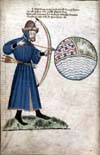|
NB. A brief description of all the manuscripts of the Confessio amantis, with reproduction of a page in the hand of each scribe, detailed palaeographical analysis of the hand(s), and images of individual letters, is now provided on the website, Late Medieval English Scribes, by Linne Mooney, Simon Horobin and Estelle Stubbs. www.medievalscribes.com. This description has been prepared with the help of Linne Mooney.
Fairfax 3
Oxford, Bodleian Library MS Fairfax 3
Confessio Amantis, with Latin poems and rubrics and the French Traitié
c. 1400
CONTENTS
(fol.1)
flyleaf, blank
(fol.2ra-186v)
Confessio Amantis, Prol.1 – VIII.3172 end
Torpor hebes sensus scola parua labor /minimusque, etc. (6 lines of Latin verse).
Off hem þat written vs/tofore <> Oure ioye may ben endeles
Prologue (fol.2ra);
Book I (fol.8rb);
Book II (fol.27va);
Book III (fol.47va);
Book IV (fol.62rb);
Book V (fol.82va);
Book VI (fol.125va);
Book VII (fol.138vb, Latin; fol.139ra, English);
Book VIII (fol.168vb).
The text has been extensively revised (see Macaulay, II.clvi-clix; Nicholson 1984, 1987, 2012, also in private communications; Parkes 1995: 89-90). Scribe 1 wrote the whole poem, fols 2r-185v, but fols 2 and 185 have been replaced. Scribe 2 wrote fol.185, a leaf inserted in place of the one cut away, containing VIII.2967-3146, with the preceding 29 lines (VIII.2938-66) copied in on fol.184v over the same number of lines erased. Scribe 3 wrote the first leaf of the text, to replace the one cut away, with Prologue 1-146, and also fols 186-194, including the last lines of the English poem (VIII.3147-72), the Latin poems and rubrics, and the French Traitié. Scribe 2 removed Venus’ praise of Chaucer as it appears in earlier versions of the poem (VIII.2941-70*), replacing it with lines that do not mention Chaucer; and he replaced the praise of Richard II from earlier versions with a lament for the state of England. Scribe 3 replaced the leaf containing the final lines of the revised epilogue (VIII.3147-72) with new leaves containing these lines plus the other contents, as listed below. Scribe 3 also replaced the reference to Richard II’s ‘commissioning’ of the book in the Prologue with a reference to ‘a bok for Engelondes sake’ and mention of Henry of Lancaster, and he added a marginal gloss at Prol.193 and erased one at Prol.331. It is not possible to determine if Scribe 3’s alterations at the beginning of the manuscript occurred before, after, or simultaneous with either Scribe 2’s or his own alterations at the end. The original scribe added passages not present in earlier versions of the poem in order to deal with problems of layout caused by the effort to place the beginnings of tales or sections in the first line of the column and to add text so that column-for-column copying of the exemplar could begin at fol.22. These changes involved the composition of 26 new English lines that can be associated only with the poet’s direct intervention.
(fol.186r)
‘Explicit iste liber’
Explicit iste liber <> sub eo requiesce futurus
Macaulay, III.478. Later 6-line version with dedication to the earl of Derby
(fol.186r)
‘Quam cinxere freta’
Quam cinxere freta <> stat sine meta
With rubric ‘Epistola super huius’
Macaulay, III.479. Macaulay suggests (III.550, IV.419) that the ‘Quam cinxere’ was by Ralph Strode (‘a quodam philosopho’)
(fols 186v-190r)
Traitié pour essampler les amantz marietz
Puisquil ad dit cy deuant <> saluement tenir (prose rubric)
Le creatour de toute creature <> lamour parfit en dieu se iustifie
Quis sit vel qualis <> omne latus (concluding rubric)
Macaulay, I.391-2
(fol.190v)
Carmen de variis in amore passionibus
Est amor in glosa <> adhibo thorum
Macaulay, IV.359
(fols 190v-194r)
Carmen super multiplici viciorum pestilencia
Non excusatur <> iura tenenda deo
Macaulay, IV.346
(fol.194r)
‘Quia unusquisque’
Quia unusquisque <> specialiter sortitus est
Long concluding rubric to the Confessio, listing Gower’s three main works. Later version, with condemnation of Richard II and praise of Henry of Lancaster, earl of Derby
Macaulay, IV.360
(fol.194v)
‘Eneidos Bucolis’
Carmen quod quidam Philosophus <> gratanter transmisit (prose rubric)
Eneidos Bucolis que Georgica <> laus sit habenda locis
Macaulay, IV.361
ILLUSTRATION
There are two miniatures. The first is the statue of Nebuchadnezzar’s dream (‘The Dream of Precious Metals’), showing Nebuchadnezzar in bed, the Image and a hill beside, as is usual, but also showing the differentiation of metals, which is not. See Pächt and Alexander, III, pl.71. The image appears at the beginning of the poem, fol.2ra, and occupies 18 lines. The other shows the Confession scene, Genius dressed in green with a wreath of roses on his head, not much like a priest (Scott 1996, II.110), the penitent, kneeling, wearing a hood and collar of SS with a badge, probably a swan, hanging from it. The collar and badge, perhaps added later, are part of the Lancastrian livery, maybe indicating that the penitent is John Gower. The picture, reproduced in Griffiths 1983 165, appears at the beginning of Book I (fol.8ra) and occupies 16 lines. The two illustrations are of modest quality.
DECORATION
Fairfax 3 was used by Macaulay as his copy-text, and his division of the poem into paragraphs and sections corresponds exactly to the hierarchy of the decorated initials. One-line decorated initials are used for the Latin verses and for minor text-divisions (corresponding to Macaulay’s paragraphs), 3-line decorated initials, with pen-flourishing, for major text-divisions (Macaulay’s line-spaces), 4-line decorated initials, with flourishing, for other major text-divisions, especially those that follow Latin verses (e.g. I.575, 1235, 1343, &c.), and 6-line decorated initials, combined with borders, for the beginnings of all books except the Prologue (4-line). The borders consist of a single decorated column on the left, alone (Prol.) or with lateral extensions the width of the page at top and bottom (II, III, VI, VII) or at the bottom only (V); or a single decorated column between the text-columns with lateral extensions to left and right at top and bottom (IV, VIII) or at the bottom only (I). In the French and Latin poems, the same kind of hierarchy of initials is observed, as appropriate to the different structure of the poems, but with no borders.
PHYSICAL DESCRIPTION
I.
Parchment, 390 x 235 mm.
II.
Foliation, i (flyleaf) + 193 + i (flyleaf). Foliated (modern) to include flyleaves (also the endleaf, as fol.196)
III.
Collation, quires of 8 with catchwords, I – xxiii8, xxiv6, xxv4 wants 4. The leaves of quire 7 are disarranged, as Macaulay explains, II.clvii.
IV.
Written space. In two columns, 46 lines per column. Ruled. Running titles across opening (Liber primus, &c.), except Prologus. Confessor, Amans, &c. consistently in margin, without decoration or paraph (paraphs are never used in this MS). Latin verses pushed out when in the left column into the left margin (to avoid running on the longer Latin lines into the central column); where books begin in the left column (recto or verso), the border is pushed out around the protruding Latin verses (III, VI, VII, VIII), and in one case the whole border is pushed out left to accommodate the Latin marginal summary as well (V); in the right column, the Latin verses are lined up with the regular margin, sometimes with a lightly decorated vertical line in the central column to ensure the correct line-up (e.g. fols. 16v, 18v, 21v, &c.). Sometimes this line migrates to the left of the left column (perhaps to make sure decorated initials are properly lined up? e.g. fols.148r, 156r, 164r, &c.). The differentiation in the treatment of the Latin verses in left and right columns is well illustrated in those groups of verses that run over the two columns (e.g. fols. 23ra and 23rb, 138vb and 139ra, 112va and 112vb, &c.). Latin summaries are in the margins, placed in relation to the main text in the exact positions observed by Macaulay; long summaries often run out under one or both of the text-columns, e.g. fols 8vb, 14vb, 21v, 22r, 25v (an extreme example, I.3067).
V.
One very good hand, with later interventions by two other hands, as explained in the description of the text, above. Many corrections by original hand, especially to correct the use of final –e (described in detail by Macaulay, II.clix).
VI.
Careful punctuation, including a raised point to mark a strong caesural break after enjambement. There is detailed description by Macaulay, II.clix. There is also arbitrary use of various forms of punctuation at the ends of lines.
ADDITIONS
(fol.1)
‘Sr Thomas fayrfax of Denton Knighte true owner of this booke, 1588’
(fol.2)
‘The Ladie Isabell Fairfax daughter and hare of Thwats hir bouk’
(fol.8)
‘This boke belongeth to my lady farfax off Steton’
(fol.42r, across bottom)
‘Dominus illuminacio mea/ et salus mea quem timebo’. Psalm 27:1 (Vg. Ps. 26:1). In a good s.xv hand.
(fol.69r, top margin)
‘Nota fabula pro mulieribus’, referring to the story of Rosiphelee, IV.1245, a favourite for such annotation by readers (Harris 1993 227)
(fol.100r, central space between text-columns)
‘Thystory of Jason and Medea’, V.2232
(fol.109va)
‘adryan and bardus’, at V.4937, beside initial at beginning of tale . Another favourite tale for readers’ annotation (Harris 1993 229)
(fol.194r, across bottom)
‘Confessio Amantis’. Informal s.xv hand
(fol.195r-v)
Latin moral treatise in close heavily abbreviated script (s.xiv)
PROVENANCE
Lady Isabel was the granddaughter and heiress of John Thwaites of Denton, in Yorkshire, who died in 1511. She was married to Sir William Fairfax of Steeton, also in Yorkshire. Sir Thomas Fairfax was her grandson. The book was bequeathed to the University of Oxford by Sir Thomas Fairfax, the parliamentary general, grandson of the above Sir Thomas Fairfax, and was placed in the Bodleian Library in 1675. Macaulay, II.clvii.
BIBLIOGRAPHY
Griffiths, Jeremy, “Confessio Amantis: The Poem and its Pictures,” in A.J.Minnis (ed.), Gower's Confessio Amantis: Responses and Reassessments (Cambridge: D.S.Brewer, 1983), pp.163-78.
Harris, Kate, “Ownership and Readership: Studies in the Provenance of the Manuscripts of Gower's Confessio Amantis.” Unpublished D.Phil. dissertation, University of York, 1993.
Macaulay, G.C. (ed.), The Complete Works of John Gower, 4 vols. London: Oxford University Press, 1899-1902. Vol.I, The French Works; Vols.II and III, The English Works; Vol.IV, The Latin Works. Vols II and III were simultaneously published for the Early English Text Society as Vols I and II, Extra Series 81-82 (Oxford, 1901).
Nicholson, Peter, “Gower's Revisions in the Confessio Amantis.” Chaucer Review, 19 (1984), 123-43.
Nicholson, Peter, “Poet and Scribe in the Manuscripts of Gower's Confessio Amantis,” in Derek Pearsall (ed.), Manuscripts and Texts: Editorial Problems in Later Middle English Literature (Cambridge: D.S.Brewer, 1987), pp.130-42.
Nicholson, Peter, ‘Gower’s Manuscript of the Confessio Amantis,” in R.F.Yeager and Toshiyuki Takamiya (eds), The Medieval Python: The Purposive and Provocative Work of Terry Jones (New York: Palgrave/Macmillan, 2012), pp.75-86.
Pächt, Otto, and J.J.G.Alexander, Illuminated Manuscripts in the Bodleian Library, Oxford: Vol.3, British, Irish, and Icelandic Schools (Oxford, 1973).
Parkes, M.B., “Patterns of scribal activity and revisions of the text in early copies of works by John Gower,” in Richard Beadle and A.J.Piper (eds), New Science out of Old Books: Studies in Manuscripts and Early Printed Books in Honour of A.I.Doyle (Aldershot: Ashgate/Scolar Press, 1995), pp.81-121.
Scott, Kathleen L., Later Gothic Manuscripts 1390-1490 (A Survey of Manuscripts Illustrated in the British Isles, general editor, J.J.G.Alexander), 2 vols (London: Harvey Miller, 1996).
|


